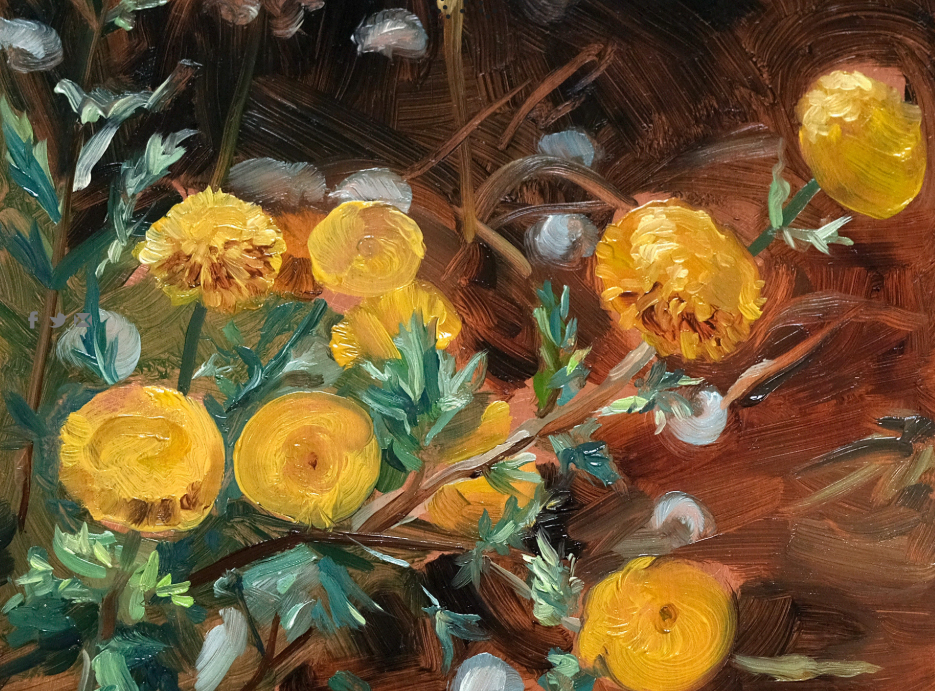JULIEN AUDEBERT ANOTHER GREEN WORLD

A personal exhibition by Julien Audebert.
It is common in history of art where the commentary is applied in order to elucidate the personal reversals
of avant-garde works in a traditional pictorial practice. One of these eternal “returns” which has always been
about updating the function of critique. If no one asks themself such a question in the midst of this floral eruption, let us firstly bet that the strength to question figurative painting perceived as a regressive act would
be inexhaustible, and secondly that it is indeed a practice adapted to the climate of crisis (without taking to account that it doesn’t require electricity and does not fear a computer collapse).
Julien Audebert’s new exhibition “Another green world” at gallery Art : Concept gives a large place for (handmade) paintings of flowers and landscapes. This could be surprising when the last ten years of his work
are characterised by a critical analysis of the production and reception of (mechanical) images in various processes of deconstruction and rearrangements. One could ask oneself what remains of the theme of History,
hitherto predominant, in an exhibition where the human figure is absent and only one date is given (1798). What’s more, would this sudden naturalist surge, at least the bucolic atmosphere or even the accentuated repetition of the floral motif have really ended war, however central in the last exhibition (“Périodes”, 2016) – and all of this with a relaxed air of Brian Eno, off which the artist borrows his title? Added to this antilogy, the artist borrows from the decorative register and the techniques of the minor arts by replacing classic references of cinema and great literary works (J. Renoir, S. Einsentein, E. Muybridge, W. Benjamin, J. Michelet…). Equally, would the evocation of the battlefield (Nocturnes), or of a cosmic spatiotemporal scale (Mars & Venus, phases d’opposition) which charted “Périodes”, be restrained to the reference of the domestic space which these paintings on copper were predestined for, and of which the format and support refer back in part to the widespread art of enamel in northern Europe between the sixteenth and eighteenth centuries?
Maybe it is the sheer volume that renders this collection of flower portraits suspect in our eyes, even if the main
title, Les obsidionales, (obsidional flora) indicates directly that it refers to a botanical inventory. Because these little plaques with their warm reflections provoke other reminiscences: maybe the portable icons which would have been shown to the pre-Colombians, it would have sufficed to unveil them under the sun of the Andes to activate their power of enlightenment. It would seem logical here to fall again to the primitive cult of images
where opposing/phantom symbols appear when perception is compensated by projection, where, after all, the relationship between what is seen and what is shown is the most unstable.
« Maybe my brains have turned to sand », sings Eno. Further away, one notices the level of water over the pine tops, in the submerged sceneries of the series Eden. Let us note that these are again paintings of images and that these images are aquariums, where the glass and the surface of the canvas melt into one single screen, projecting a superposition of images. Once more a blurred reflection, which condenses several representations: fantasises of a virgin nature organised for the human eye, in which the artist rescues models of 18th century pictorial compositions (which are also reminiscent of the opening scene of Bambi). Incidentally he asks whether or not the aquarium is the last sanctuary of romanticism, although the rambler was driven out, like humanity – of this nature which by giving a magnified version of itself slipped towards the artifice and left behind the referent. Before these tautological landscapes, one asks oneself whether the title “Another green world”, or more so its cover version, is to be heard like a tune or a promise? And in this case, is it one of another world which never happened, or again of the same world? Which of the two was recreated in these aquatic illusions at a time where the idea of collapse is spreading? We know that the passion for the aquarium was born from modernity, and that the way that it kept alive the myth of Atlantis was a final search for redemption (1). Also, the development of interior design in the bourgeois milieu, from which these enchanted miniature worlds emerged, made it possible to protect oneself in the private sphere from the violent reconfiguration of the public sphere (the systematic purification of contemporary interiors is a consequence).
We should then turn back down the path towards the flower paintings, and remind those who did not follow, that these are flowers of the outdoors. More precisely, their territory is that of a battlefield. It was
through nights of photography in the area of the river Meuse that the artist found these substances named
“obsidionales” (obsidional flora), to determine the way in which they are planted. Here is another way to explain the change of medium: the artist photographed a site; he found plants and decided to paint them. All of them were displaced from their environment in movements linked to armed conflicts (swept along under the shoes of the soldiers who cultivated the military camps). These are migrant flowers, unplanned forms of life. This perhaps explains the insistence of their enumeration in a quick, urgent gesture. They model a story of resistance to ambient speeches, which are indirectly summoned by the illegible presence of inactual texts, embedded in a publication date (Inclusion, 1798). This last image, of micrographic texts, overlaps an American anti-immigration law (Alien sedition act) and An Essay on the Principle of Population by Thomas Robert
Malthus, who developed radical theories to resolve the imbalance between population growth and the
availability of resources.
(1) see Celeste Olaquiaga, Royaume de l’artifice, Fage, 1990.
Written by Julie Portier. Translated by Alice King